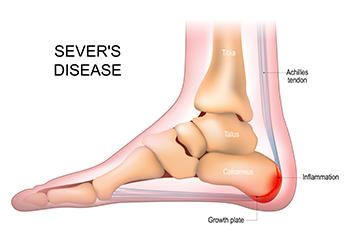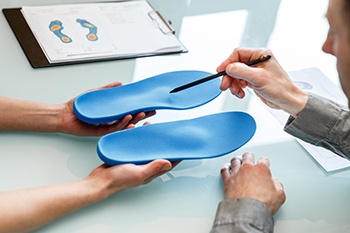
Sever's disease, also known as calcaneal apophysitis, is a foot condition in growing children, particularly those active in sports. It occurs when the growth plate in the heel becomes irritated, causing pain and swelling in the heel. Symptoms typically include pain at the back or bottom of the heel, especially after physical activity or prolonged standing. The pain may be sharp or aching, and the child may have difficulty walking or running without discomfort. A podiatrist can help diagnose Sever’s disease through a physical exam and may suggest treatments to alleviate pain and reduce inflammation. This type of doctor can provide guidance on stretching exercises, custom orthotics, or cushioned heel pads to help relieve pressure on the heel. In some cases, changes in footwear or activity level may be necessary to prevent further irritation. If your child has heel pain, it is suggested that you schedule an appointment with a podiatrist who can effectively manage Sever's disease.
Sever's disease often occurs in children and teens. If your child is experiencing foot or ankle pain, see one of our podiatrists from Riznyk Podiatry. Our doctors can treat your child’s foot and ankle needs.
Sever’s Disease
Sever’s disease is also known as calcaneal apophysitis, which is a medical condition that causes heel pain I none or both feet. The disease is known to affect children between the ages of 8 and 14.
Sever’s disease occurs when part of the child’s heel known as the growth plate (calcaneal epiphysis) is attached to the Achilles tendon. This area can suffer injury when the muscles and tendons of the growing foot do not keep pace with bone growth. Therefore, the constant pain which one experiences at the back of the heel will make the child unable to put any weight on the heel. The child is then forced to walk on their toes.
Symptoms
Acute pain – Pain associated with Sever’s disease is usually felt in the heel when the child engages in physical activity such as walking, jumping and or running.
Highly active – Children who are very active are among the most susceptible in experiencing Sever’s disease, because of the stress and tension placed on their feet.
If you have any questions, please feel free to contact our office located in Orchard Park, NY . We offer the newest diagnostic and treatment technologies for all your foot and ankle injuries.

Orthotics come in three main types, each offering different levels of support and customization. Off-the-shelf, or OTS insoles, are mass-produced and provide cushioning and mild correction but may not address specific biomechanical issues. Functional foot orthoses, FFOs, are semi-custom devices made from durable materials like plastic or graphite, improving foot alignment and redistributing pressure to help with conditions like plantar fasciitis or overpronation. Custom-molded total contact insoles, TCIs, offer the highest level of customization, crafted from a detailed mold of the foot to ensure maximum contact and even weight distribution. They are ideal for individuals with diabetes, severe deformities, or chronic pain. Choosing the right type of orthotic depends on foot structure, medical conditions, and activity level. For the best results, it is suggested that you consult a podiatrist to determine which orthotic is best suited to your needs.
If you are having discomfort in your feet and would like to try orthotics, contact one of our podiatrists from Riznyk Podiatry. Our doctors can provide the care you need to keep you pain-free and on your feet.
What Are Orthotics?
Orthotics are inserts you can place into your shoes to help with a variety of foot problems such as flat feet or foot pain. Orthotics provide relief and comfort for minor foot and heel pain but can’t correct serious biomechanical problems in your feet.
Over-the-Counter Inserts
Orthotics come in a wide variety of over-the-counter inserts that are used to treat foot pain, heel pain, and minor problems. For example, arch supports can be inserted into your shoes to help correct overarched or flat feet, while gel insoles are often used because they provide comfort and relief from foot and heel pain by alleviating pressure.
Prescription Orthotics
If over-the-counter inserts don’t work for you or if you have a more severe foot concern, it is possible to have your podiatrist prescribe custom orthotics. These high-quality inserts are designed to treat problems such as abnormal motion, plantar fasciitis, and severe forms of heel pain. They can even be used to help patients suffering from diabetes by treating foot ulcers and painful calluses and are usually molded to your feet individually, which allows them to provide full support and comfort.
If you are experiencing minor to severe foot or heel pain, it’s recommended to speak with your podiatrist about the possibilities of using orthotics. A podiatrist can determine which type of orthotic is right for you and allow you to take the first steps towards being pain-free.
If you have any questions please contact our office located in Orchard Park, NY . We offer the newest diagnostic and treatment technologies for all your foot and ankle needs.

Ankle pain during ice skating can be caused by several factors. One of the primary reasons is poorly fitting skates. If the skates are too tight or too loose, they can put excessive pressure on the ankles, leading to discomfort or injury. Another cause is poor skating technique. Incorrect posture or improper alignment while skating can strain the ankle joint and surrounding muscles, contributing to pain. Ankle overload is also a factor, as ice skating places a significant amount of pressure on the ankles, especially during jumps, sharp turns, or extended sessions. A lack of fitness or weak muscles in the lower legs can further worsen the issue, making it difficult for the body to properly support the ankles during skating. If your ankles or feet hurt from ice skating, it is suggested that you consult a podiatrist who can offer effective relief methods, and guide you on foot protection while skating.
Sports related foot and ankle injuries require proper treatment before players can go back to their regular routines. For more information, contact one of our podiatrists of Riznyk Podiatry. Our doctors can provide the care you need to keep you pain-free and on your feet.
Sports Related Foot and Ankle Injuries
Foot and ankle injuries are a common occurrence when it comes to athletes of any sport. While many athletes dismiss the initial aches and pains, the truth is that ignoring potential foot and ankle injuries can lead to serious problems. As athletes continue to place pressure and strain the area further, a mild injury can turn into something as serious as a rupture and may lead to a permanent disability. There are many factors that contribute to sports related foot and ankle injuries, which include failure to warm up properly, not providing support or wearing bad footwear. Common injuries and conditions athletes face, including:
Sports related injuries are commonly treated using the RICE method. This includes rest, applying ice to the injured area, compression and elevating the ankle. More serious sprains and injuries may require surgery, which could include arthroscopic and reconstructive surgery. Rehabilitation and therapy may also be required in order to get any recovering athlete to become fully functional again. Any unusual aches and pains an athlete sustains must be evaluated by a licensed, reputable medical professional.
If you have any questions please feel free to contact our office located in Orchard Park, NY . We offer the newest diagnostic and treatment technologies for all your foot and ankle needs.